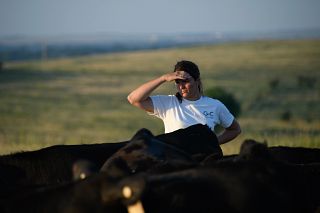Cow/Calf
Cattlemen have long recognized the need to properly care for livestock. Ranchers and producers have a moral and ethical responsibility to ensure, to the best of their ability, the health and well-being of the livestock in their care.
What is the existing metric?
- Has the operation adopted Beef Quality Assurance (BQA) or similar program principles into management of the farm or ranch?
What is the sector target?
- Increase the number of individuals trained and certified in BQA or equivalent by 10% year-over-year.
Auction Market
The Beef Quality Assurance (BQA) program and its accompanying guidelines cover the major areas of animal nutrition, health, care, and handling. Adaption of these scientifically based practices allow the beef value chain to produce healthier cattle with the least stress levels. The Livestock Marketing Association (LMA) recommends the use of the LMA Guide to Animal Handling and Employee Training which, rooted in BQA principles, adapts the principles to the unique handling challenges of an auction market environment.
What is the existing metric?
- Are employees trained and auction-specific Beef Quality Assurance (BQA) principles being implemented at the auction market?
What is the sector target?
- All cattle handling employees of livestock marketing businesses represented by USRSB member organizations are trained through BQA or Livestock Marketing Association (LMA) by 2030.
Feedyard
The Beef Quality Assurance program (BQA) and its accompanying guidelines cover the major areas of Animal Nutrition, Health, Care, and Handling. Adoption of these scientifically based (Grandin, 2016; Grandin, 2015) practices allows feedyards to produce healthier, lower-stressed animals.All feedyard employees in a livestock handling role are trained and certified in BQA principles by 2030.
What is the existing metric?
- Are feedyard employees trained in Beef Quality Assurance (BQA) principles and are these principles implemented at the feedyard?
What is the sector target?
- All feedyard employees in a livestock handling role are trained and certified in BQA principles by 2030.
Packer & Processor
Research demonstrates that stressful handling during loading and unloading of animals can decrease carcass quality and yield. Additionally, improper handling of cattle can result in team member health and safety concerns. Finally, ensuring that cattle health and welfare are prioritized on site is crucial in avoiding injuries to cattle.
What are the existing metrics?
- Level 1
- Packer: Does the company have a comprehensive animal welfare program including third-party verification?
- Processor: Does the company have a documented animal welfare policy (or equivalent) and encourage the adoption of the U.S. Beef Industry Sustainability Framework’s animal health and well-being metrics?
- Level 2
- Packer: What was the company’s total number of USDA non-compliance animal welfare violations per 100,000 head processed in the previous calendar year?
- Packer: What percentage of cattle come under a third-party audit? What percentage pass on first audit?
- Processor: Does the company used second-or-third party animal welfare audits, such as the North American Meat Institute’s (NAMI) Animal Handling Guidelines and Audit Guide, to verify policy compliance to at least the packer level?
- Level 3
- Does the company track animal health and well-being over time and set goals for continued improvement?
- Does the company engage its suppliers or participate in partnerships, initiatives or programs and/or engage its suppliers to advance continuous improvement regarding animal health and well-being in the beef value chain
What is the sector target?
- By 2025, all beef packers who handle animals will pass third-party animal transport and handling audits and all packers and processors will require all suppliers to implement mandatory employee training and follow BQA standards for animal care.
Retail & Foodservices
The Retail and Food Service Sector plays an important role in the beef value chain by interacting with consumers directly, listening to their needs, and providing the beef products they desire. Although the Retail and Food Service Sector does not directly interact with live animals, their health and well-being play an important role in being a responsible business, delivering consistent, quality products, and meeting changing consumer and other stakeholder expectations.
What are the existing metrics?
- Level 1
- Does the company have a documented and publicly available animal care and handling policy?
- Does the company encourage the adoption of USRSB metrics in its beef value chain?
- Level 2
- Does the company verify compliance with its policy at least to the packer level?
- Does the company have a policy for audit
- Level 3
- Does the company engage its suppliers on continuous improvement and emerging issues regarding animal health and well-being in its beef supply chain?
- Does the company track and assess progress on animal health and well-being outcomes that align with its policy?
What are the sector targets?
- All USRSB member retail and foodservice companies have a publicly available animal care and well-being policy by 2023.
- All USRSB member retail and foodservice companies have implemented concrete steps to encourage the adoption of U.S. Beef Industry Framework metrics and measuring progress against metrics by 2025.






